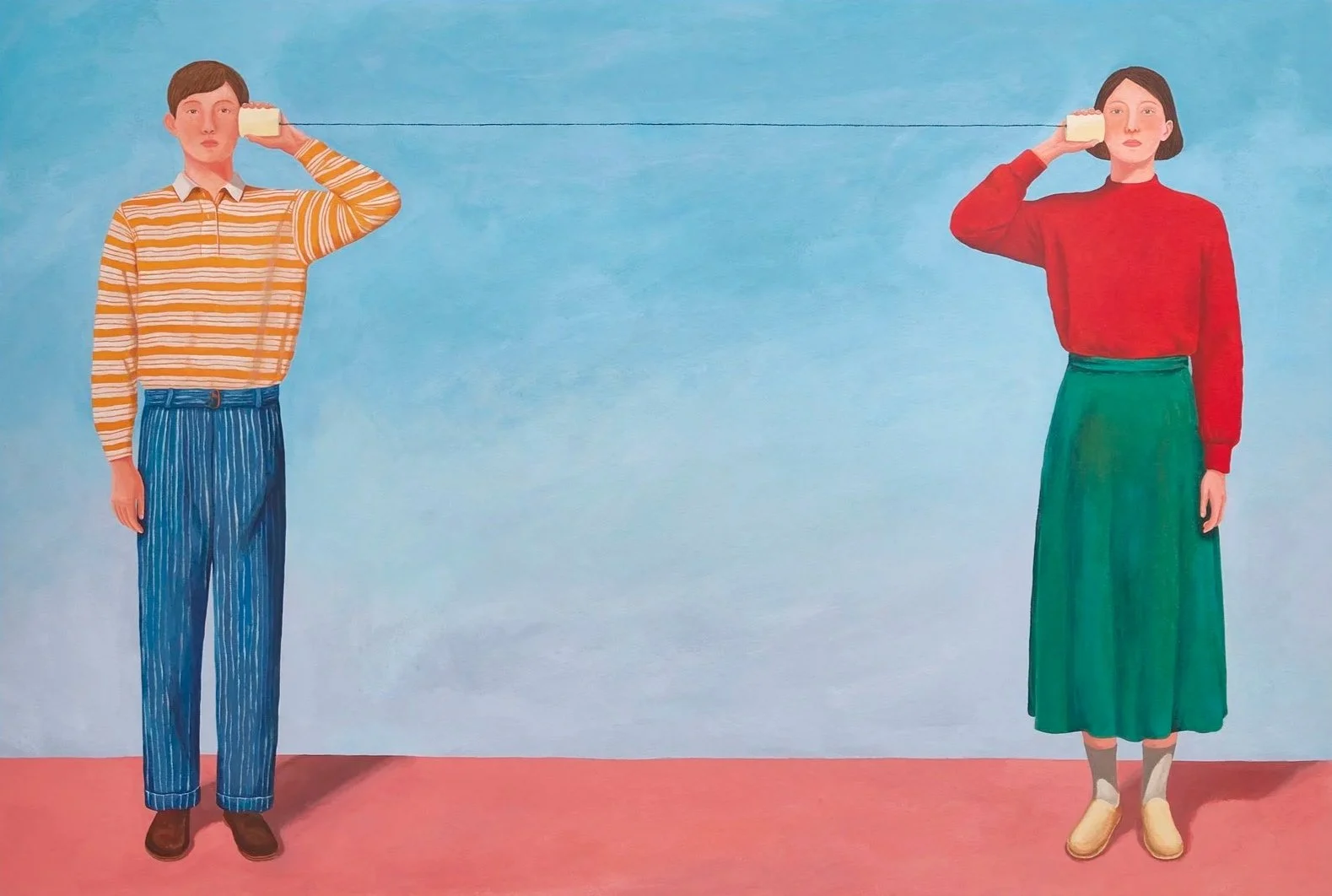Essential Guide to Miscommunication: 들을 준비, 2025, gouache on Korean paper, 60.6 × 90.9 cm
“Essential Guide to Miscommunication: Ready to Listen” explores the structural defect inherent
in the very act of attempting to connect.
The two figures in the work hold paper-cup telephones,
seemingly linked by a single thread, yet both remain in the position of listening.
In the absence of transmission—the essential premise of dialogue—they believe they are communicating.
This scene visualizes a structure that is “attempted, yet never realized,”
a failure of connection embedded within the very form of communication.
The paper-cup telephone, once a childhood toy and a symbol of simple connection,
appears here stripped of its original function.
The thread is neither cut nor fully joined.
Through this paradox, the work reveals a communication structure destined to malfunction—
a system in which the very will to connect contains the seed of its own impossibility.
Rather than depicting communication failure as tragic,
I sought to reveal it as an intrinsic premise of human relationships,
a behavioral structure that repeats itself endlessly.
The two figures face each other, attempting to converse,
yet their attempt is doomed from the start.
This moment transforms into “a game of impossibility disguised as communication,”
marking the conceptual origin of the “Essential Guide to Miscommunication” series.
In “Essential Guide to Miscommunication: Ready to Listen”,
the act of listening exposes the disjunction between intention and result,
and questions the unstable structure of what we call understanding.
The viewer encounters a scene where speech and hearing fall out of balance—
a conversation never delivered.
Within that silence, the work asks what it truly means to listen, and whether communication is ever fully possible at all.
The series does not deny the inherent imperfection of relationships.
Instead, it seeks resonance and reflection within that very flaw.
The title “Essential Guide to Miscommunication” begins from the awareness that communication and connection are, by nature, incomplete.
By presenting this irony, the artist reveals that every attempt at connection is already bound within a defective structure—
and that the defect itself is the essence of relationship.
“Essential Guide to Miscommunication: 들을 준비”는 관계의 시도 속에 이미 내재된 소통 구조의 결함을 탐구한다.
작품 속 인물들은 종이컵 전화기를 들고 서로 연결되어 있지만, 두 사람 모두 ‘듣는 행위’에만 머물러 있다.
즉, 대화의 전제가 되는 ‘전달’이 부재한 상태에서, 그들은 자신들이 소통하고 있다고 믿는다.
이 장면은 “시도되지만 결코 성립되지 않는 구조”,
즉 연결의 실패를 시각화한다.
종이컵 전화기는 어린 시절의 놀이이자, 단순하고 직접적인 연결의 상징이다.
그러나 작품 속에서는 그 본래의 기능을 잃은 채 존재한다.
끊어지지 않았지만 닿지도 않는 실, 듣고 있지만 아무 말도 하지 않는 인물들—
이 모든 요소는 관계의 시작점에서 이미 작동 불가능한 소통의 역설적 구조를 보여준다.
작가는 이 작품을 통해 ‘소통의 실패’를 비극적으로 그리기보다,
그것이 인간 관계의 본질적 전제이자 반복되는 행위 구조임을 드러내고자 했다.
서로를 향해 선 두 사람은 대화를 시도하지만, 그 시도는 처음부터 실패로 예정되어 있다.
이는 곧 “소통하려는 행위 그 자체가 하나의 불가능한 놀이”로 전환되는 순간이며,
“Essential Guide to Miscommunication” 시리즈의 출발점이기도 하다.
“Essential Guide to Miscommunication: 들을 준비”는 ‘듣는다’는 행위를 통해 관계의 의도와 결과 사이의 단절,
그리고 소통이란 믿음의 불안한 구조를 드러낸다.
관객은 이 장면을 통해 말과 청취의 균형이 무너진 상태—
즉, “전해지지 않은 대화의 장면”을 마주하게 된다.
그 안에서 우리는 소통이란 무엇이며,
정말 누군가를 ‘듣는다’는 것은 어떤 의미인가를 다시 묻게 된다.
이 시리즈는 관계의 불완전함을 부정하지 않는다.
오히려 그 결함 속에서 감응과 성찰의 가능성을 찾는다.
시리즈 제목 “Essential Guide to Miscommunication (연결에 실패하기 위한 필수 지침서)”는
‘소통과 관계는 본질적으로 완전할 수 없다’는 인식에서 출발한다.
작가는 이 아이러니한 제목을 통해,
관계를 맺으려는 모든 시도가 이미 결함을 내포한 구조 안에서 이루어진다는 사실을 역설적으로 드러내며,
그 결함 자체를 관계의 본질로 제시한다.
